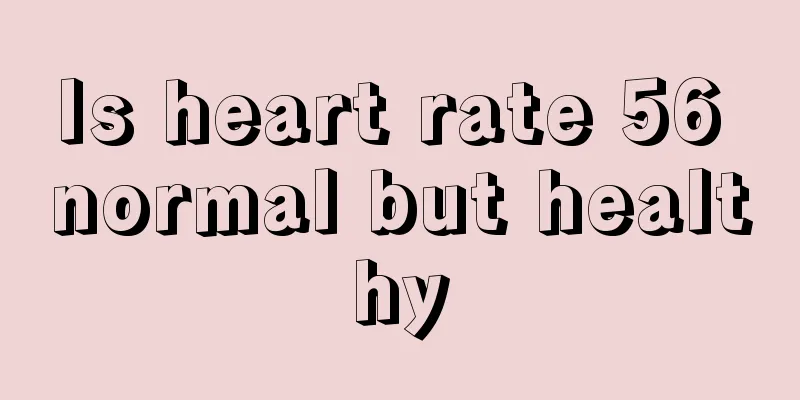Is heart rate 56 normal but healthy

|
Heart rate is an important criterion for measuring whether the human body is healthy. Generally speaking, a normal adult's heart rate is between 60 and 100 beats per minute. If the heart rate is 56, which is lower than 60 beats, this is a manifestation of sinus bradycardia. It may also indicate that there are certain problems with your health and you need to go to the hospital for examination in time. Below, I will introduce you to the relevant knowledge about heart rate in detail. 1. Normal heart rate The heart rate of a healthy adult is 60 to 100 beats per minute, most of them are 60 to 80 beats per minute, and women are slightly faster; children under 3 years old are often above 100 beats per minute; the elderly are slower. 2. Manifestations of Arrhythmia A heart rate of more than 100 beats per minute in an adult (generally not more than 160 beats/minute) or more than 150 beats/minute in an infant is called sinus tachycardia. It is common in normal people after exercise, excitement, agitation, smoking, drinking and strong tea. It can also be seen in fever, shock, anemia, hyperthyroidism, heart failure and the use of atropine, epinephrine, ephedrine, etc. If the heart rate is between 160 and 220 beats per minute, it is often called paroxysmal tachycardia. A heart rate lower than 60 beats/minute (generally above 40 beats/minute) is called sinus bradycardia. It can be seen in people who engage in heavy physical labor for a long time and in athletes; pathologically, it can be seen in hypothyroidism, increased intracranial pressure, obstructive jaundice, and overdose or poisoning of digitalis, quinidine, or propranolol. If the heart rate is less than 40 beats/min, atrioventricular block should be considered. A heart rate that is too fast, exceeding 160 beats/minute, or less than 40 beats/minute, is mostly seen in patients with heart disease. Patients often experience palpitations, chest tightness, and discomfort in the precordial area. A detailed examination should be conducted early so that treatment can be targeted at the cause. The amount of blood output from the ventricles to the arteries each time the heart contracts is called the stroke volume, and the amount of blood output by the heart per minute is called the minute volume. The stroke volume of a normal person in a resting state is 70 ml. If the heart rate is calculated at 75 beats per minute, the minute volume is approximately 5250 ml. The amount of cardiac output is an indicator of the heart's working capacity. 3. Notes on heart rate check Requirements during the examination: The patient should actively cooperate with the doctor during the examination, should not do strenuous exercise one hour before the examination, and should not be overly nervous during the examination to avoid affecting the results. |
>>: Toona sinensis is preserved until the Chinese New Year
Recommend
Methods and contents of subclavian vein puncture
Subclavian vein puncture is a common emergency me...
Can nasopharyngeal cancer be inherited from generation to generation?
Can nasopharyngeal cancer be inherited from one g...
Which hospital is good at treating bone cancer
Which hospital is good at treating bone cancer? H...
What are the folk remedies for treating lung cancer? A complete list of folk remedies for treating lung cancer
Lung cancer is a disease that often takes a long ...
How to treat cervical cancer involving the uterine body?
Whether the cervix involves the uterus depends on...
My face is allergic and has a lot of small pimples
I believe that many people who do not have oily a...
Can I use an induction cooker to stew a casserole?
Now induction cookers have entered every househol...
Is it good to eat raw garlic frequently?
Garlic contains some special substances, so it ca...
How to take care of acne?
Acne is a skin problem that everyone will encount...
What are the dietary factors that lead to gastric cancer
The dietary factors that lead to gastric cancer a...
What to do if beans have spots
Green beans are a very common vegetable, and I be...
How to relieve pain after tooth extraction
As the saying goes, "Toothache is not a dise...
Multiple Folliculitis
Multiple folliculitis can be said to be a relativ...
Can an electric kettle boil eggs?
Eggs are something we are very familiar with. We ...
How to choose a foot bath?
Foot soaking can promote blood circulation in the...









